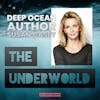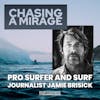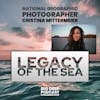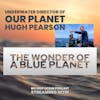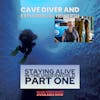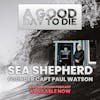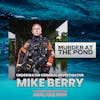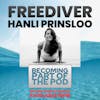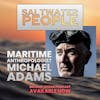Telling the Stories of the Sea: Dr Maddy McAllister on the Wonder of Shipwrecks and Maritime Archaeology

In today's episode, I speak with Dr. Madeline McAllister, senior Curator of Maritime Archaeology at the Queensland Museum and James Cook University in Townsville, Australia.
Dr McAllister, or Maddy as she's called, focuses her work on historic shipwrecks and underwater archaeology in Australasia, with a special interest in shipwrecks on the Great Barrier Reef. And this comes as no surprise as her offices look out over the water in eastern Australia, where the Great Barrier Reef lies just offshore.
I find maritime archaeology fascinating as it lies at the nexus of history and the ocean, two of my passions. But it takes a good storyteller to make those lost shipwrecks engaging, nd Maddy's enthusiasm and sense of humor brought the ideas of maritime archaeology to life.
And so Maddy talked about how her grandfather had a deep impact on her life's path in the ocean, a moment where everything seemed to come together as she dove a wreck called the Rapid in Western Australia on Ningaloo Reef, and how underwater Maritime Srchaeology can inform our understanding of human society far beyond the water.
Hi and welcome to the Big Deep podcast. Big Deep is a podcast about people who have a connection to the ocean, people for whom that connection is so strong it defines some aspect of their life. Over the course of this series we'll talk to all sorts of people and in each episode we'll explore the deeper meaning of that connection. Today I speak with a maritime archaeologist who has a passion for uncovering the real stories of wooden shipwrecks on reefs across Australia. Hello, this is your host, jason Elias. Welcome to the Big Deep podcast.
In today's episode I speak with Dr Madeline McAllister, senior Curator of Maritime Archaeology at the Queensland Museum and James Cook University in Townsville, australia. Dr McAllister, or Maddie as she's called, focuses her work on historic shipwrecks and underwater archaeology in Australasia, with a special interest in shipwrecks on the Great Barrier Reef, which comes as no surprise as her offices look out over the water in eastern Australia where the Great Barrier Reef flies just offshore. I find maritime archaeology fascinating as it lies at the nexus of history and the ocean, two of my personal passions. But it takes a good storyteller to make those lost shipwrecks engaging. And Maddie's enthusiasm and sense of humor brought the ideas of maritime archaeology to life. And so Maddie talked about how her grandfather had a deep impact on her life's path in the ocean a moment where everything seemed to come together as she dove a wreck called the Rapid in Western Australia on Ningaloo Reef, and how underwater archaeology can inform our understanding of human society far beyond the water.
Maddy McAllister:
My name is Maddie McAllister and I'm a maritime archaeologist, so I study shipwrecks, but particularly I'm the senior curator of maritime archaeology at the Queensland Museum in Australia.
Jason Elias:
Can you tell me a bit about where you grew up and when you remember your first connection to the ocean?
Maddy McAllister:
I think my first memories really are being probably about four or five years old and staying at my grandparents' house on the beach down in the southwest of Australia. My granddad had an old lobster boat and he would go fishing all day and when I was too young to join him, we'd wait watching from the house so to see the boat appear on the horizon. He was an English Welsh farmer and farmed in Australia for a couple of decades and then retired to the beach. He would wander around with a walking stick and one of those hats, like a peeky blinders hat, and he'd always tell us stories, and I know that the aim of his stories was to scare us as kids out of entertainment for himself, so they were stories about pirates or ships disappearing or a stormy night. As a child you have that wonderful imagination and it was about putting yourself in the boots of people on ships and imagining what their lives would have been like and who they were and where they came from. Australia, like many places around the world, were a colonial nation and a lot of us have travelled from a long way away. So it was imagining the backgrounds behind these people and maybe even wonder at these fantastical wooden ships that inspired wonder in me about seafaring. So not only having that wonderful connection with fishing and the beach and a love for the sea, but then having interwoven into it these myths and legends and stories about seafaring that are very haunting and triggered me to want to know more about what it would have been like 300 years ago to be on those ships, to be in a storm. So I guess that's why he is a seminal figure for me. In my childhood he started it all really.
Jason Elias:
So obviously your grandfather had a deep impact on your young life and maybe in some ways shaped your life path, and I can't help but wonder if some of the stories he told you late at night somehow captured your young mind. You've talked in the past about how storytelling is a large part of why you like maritime archaeology, and I'm wondering whether there was a time when maybe things shifted to your own personal connection to the shipwrecks, perhaps a moment when you realised how you were becoming part of the legacy of storytellers about the sea.
Maddy McAllister:
I spent quite a few years learning about ship construction, learning about famous shipwrecks in Australia, and in 2012, I was team member on an expedition up to Ningalow Reef in Western Australia and, in particular, revisit a shipwreck called the Rapid, which sank in 1811, was an American-China trader that hit the coast and was carrying a large amount of silver bullion. So to hide the ship, the survivors burnt it down to the waterline. They excavated it in the 80s. Everything except the ship. I kind of missed that payday of a lot of the big excavations in Australia where they got all the artifacts out and found these fascinating stories. But I finally had this opportunity to join this field team and go out and dive on Rapid, which I'd read about. So jumped off the side of the boat and descended with the dive team when off we go, without drawing boards and cameras, doing a sort of check of the whole site to see how it survived over the last decade. And I swam past this bit of the ship which is the side of the hull, so out of planking of the ship, the frames in the middle and the inner planking, it had this beautiful copper bolt through it that had been sanded by the sand movement and so it was gold and shiny and I think I must have sat staring at this one bit of the ship for about 20 minutes and all of a sudden in front of me I saw these frames and this planking and the ship just seemed to all fall together. I got it like I got why shipwrecks can tell us those stories. Yeah, it was a moment of recognition of the site and what I could do and I could make a life of this and there's so much here to still tell and it's sitting right here.
Jason Elias:
Wow, that was a great explanation of what intrigues you about these wrecks. So the other side of this storytelling is also about the science and what we can learn about human society in history from these ships that were lost. What, for you, is the value in searching out and revealing the stories behind them?
Maddy McAllister:
There's stories out there that aren't as glamorous but they may give us incredible clues. For example, one that I'm working on at the moment is a recently located wreck in the far north and it's on this little reef called Five Reefs and all that's left on it is a scatter of ballast stone, some iron bits and pieces that are now cemented into the reef, some copper sheeting and this wonderful milling stone and looking at that it looks like it's from our Asian neighbors. It has a more rice mill style to it and that's all that's left. So I think it's probably from the 1800s, but I think it was carrying cargo and passengers that represent Australia at the time and I don't think it's necessarily just white colonial Australians on this ship. It's likely that, as people coming from Indonesia or from our neighboring countries and travelling to Australia, maybe some of that is in the clue of the rice mill stone. So I really love the stories that are waiting to be told and the little wrecks that might not have the exciting people association with it are clues that may tell us a great story and fills a huge gap in our history.
Jason Elias:
Yeah, I love how that illuminates stories that might not have been part of this standard narrative, and I can understand how this engages you intellectually. But now I want to ask is there some deeper, underlying reason you are drawn to wrecks which essentially are places where a disaster happened, and, if so, what is the meaning of that for you, and are there some deeper understandings we can take from that?
Maddy McAllister:
I have this crazy fascination with how dangerous the ocean can be, and I think shipwrecks are the epitome of that. They're a safe vessel that had people travelling on it and something horrible went wrong and is a reminder of just how powerful the ocean can be. You almost don't ever see that as much as when you're looking at a shipwreck site, thanks to Hollywood. When I say shipwreck, people often think of a pirate galleon sitting nicely on the sea floor with its sails still billowing and ropes still hanging. While there are examples of that, 99% of shipwrecks look much more like an aircraft. You know, 100 years after a wreck hits that reef, all that might be left are bits of copper and stones and the rest is completely gone. You always hope that you'll find something that gives you that individual story. You can place it to a human, that you can recreate their life. One can resonate with that in some way. But often we don't have that. What we have is parts of the ship that give us clues about seafaring culture. We chase these gaps that aren't in our written record. They're lost to history. But we can put it back together and with over 600 shipwrecks along the Great Barrier Reef which all look like that splattered scatter of artefacts. It's a recognition of just how fragile we are, and I think it really makes you feel human.
Jason Elias:
Finally we end every interview and every episode with a single open-ended question. We ask everyone we talk to what does the ocean mean to you?
Maddy McAllister:
I spend days and weeks in a lab, in an archive, working on books, reading about the ocean, reading about ships, and it's those times when I get to go out and completely submerge myself in the water, whether it's a wreck or it's just the reef, it's like my temple in a way. I go there and the ocean reset. It's me.
Jason Elias:
Thanks for listening to the Big Deep podcast. Next time on Big Deep.
Kinga Phillips:
Seeing a tiger shark in the water and being able to swim effortlessly next to it, or having a young hunk back, approach you and start to spin and then mimic your movements. There's something about that that is every child's fantasy, and I tingle at the idea that there are still storylines that we have to be discovered.
Jason Elias:
We really appreciate you being on this journey into the Big Deep as we explore an ocean of stories. If you like what we're doing, please make sure to subscribe wherever you listen to podcasts. Also, please find us on the socials where you can like and comment, because those subscribes, likes and comments really make a difference. For more content from our interviews in our series, photos of every guest or just to get in touch, please reach out at our website, bigdeepcom Plus. If you know someone you think we should talk to, please let us know at our Big Deep website, as we are always looking to hear more stories from interesting people who are deeply connected to our world's oceans. Thanks again for joining us.
Featured Episodes
Highlight episodes from our incredible ocean guests.























